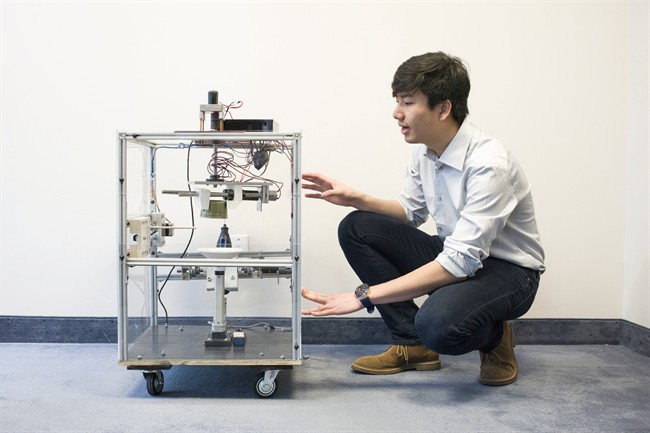TORONTO – Richard Yim was a teenager in Cambodia when he realized not all people live in near constant fear of being blown up by a landmine.

When he was eight years old, Yim’s aunt died after stepping on one of the millions of the devices that lie hidden on the country’s war-scarred landscape.
It wasn’t until he arrived in Canada that Yim, then 13, learned that death doesn’t have to be a footstep away.
He decided to study engineering, and help Cambodia and dozens of other countries where landmines kill thousands of people annually.
What started as a fourth-year engineering project for five students at the University of Waterloo morphed into a company working on a yet-to-be-named robot that can safely defuse landmines.
“It’s something that I want to work on to find a solution so that the kid in the next generation doesn’t have to go through what I have to go through when I was a kid,” said Yim.
The 22-year-old mechanical engineering graduate is now the CEO of The Landmine Boys, which he co-founded with two of the University of Waterloo team members.
Yim travelled to Cambodia with the first prototype last December. He tested the machine using landmines without explosives to see if its clamp mechanism could stabilize the detonator while slicing open the mine to melt the TNT inside.
“We were crazy enough to try to cut open a landmine,” he said.
- Budget 2024 failed to spark ‘political reboot’ for Liberals, polling suggests
- Train goes up in flames while rolling through London, Ont. Here’s what we know
- Peel police chief met Sri Lankan officer a court says ‘participated’ in torture
- Wrong remains sent to ‘exhausted’ Canadian family after death on Cuba vacation
The team is now enhancing the machine, enabling it to pick up a landmine off the ground before cutting it open. Before, it was Yim’s job to place a landmine in the robot.
He’s heading back to Cambodia in December to test the upgraded machine’s ability to handle explosive-filled landmines.
The team is aiming to then create a final version that would see the robot in an autonomous vehicle, allowing it to enter dangerous spaces without a human chaperone, pick up landmines and defuse them.
Their idea attracted the attention of the University of Waterloo’s Velocity program, which helps mentor entrepreneurs and foster startups. The Landmine Boys recently won a $25,000 prize after placing in the top four of Velocity’s triannual startup competition. Most of the company’s funding comes from grants and such competition wins.
The Velocity contest rewards teams whose pitches can be built into a sustainable, successful product business, said Mike Kirkup, Velocity’s director.
Landmines remain a deadly threat in many parts of the world. In 2014, mine action activities received about $610 million US from donors and affected states, according to the Landmine Monitor’s most recent annual report. Most of that money funded landmine clearance and risk education.
“Sadly, this is one of those businesses where you would ultimately like to work yourself out of a job,” Kirkup said.
But that’s unlikely considering the rate at which new landmines appear, he said.
The United Nations estimates more than 100 million landmines have been placed around the world since the 1960s.
Government forces in Myanmar, North Korea and Syria planted anti-personnel landmines between October 2014 and October 2015, the Landmine Monitor’s report says. As well, non-state armed groups in 10 countries used these or improvised explosive devices.
Kirkup said that while landmine detection devices exist, solutions for defusing landmines are in their infancy, and there will be a need for landmine recycling ideas and other solutions in the future.
“There is business for many years to come,” said Kirkup.
The Landmine Boys anticipates the robot will be on the market in about a year and a half.



Comments